The Induced Orientation of Hydroxypropyl Methylcellulose Coating for Ultralow Wear
Abstract
:1. Introduction
2. Experimental Section
2.1. Materials and Methods
2.2. Characterizations
3. Results and Discussion
3.1. Tribological Behaviour
3.2. Anti—Wear Morphologies
3.3. Anti—Wear Mechanism
4. Conclusions
Author Contributions
Funding
Data Availability Statement
Acknowledgments
Conflicts of Interest
References
- Ali, M.K.A. Friction and Wear in Machine Design. Lubricants 2023, 11, 40. [Google Scholar] [CrossRef]
- Myshkin, N.K.; Goryacheva, I.G. Tribology: Trends in the half−century development. J. Frict. Wear 2016, 37, 513–516. [Google Scholar] [CrossRef]
- Yin, X.; Mu, L.; Jia, Z.; Pang, H.; Chai, C.; Liu, H.; Liang, C.; Zhang, B.; Liu, D. Nanostructure of Superlubricating Tribofilm Based on Friction−Induced a−C:H Films under Various Working Conditions: A Review of Solid Lubrication. Lubricants 2024, 12, 40. [Google Scholar] [CrossRef]
- Li, T.; Chen, C.; Brozena, A.H.; Zhu, J.Y.; Xu, L.; Driemeier, C.; Dai, J.; Rojas, O.J.; Isogai, A.; Wågberg, L.; et al. Developing fibrillated cellulose as a sustainable technological material. Nature 2021, 590, 47–56. [Google Scholar] [CrossRef] [PubMed]
- Eichhorn, S.J.; Etale, A.; Wang, J.; Berglund, L.A.; Li, Y.; Cai, Y.; Chen, C.; Cranston, E.D.; Johns, M.A.; Fang, Z.; et al. Current international research into cellulose as a functional nanomaterial for advanced applications. J. Mater. Sci. 2022, 57, 5697–5767. [Google Scholar] [CrossRef]
- Tanpichai, S.; Boonmahitthisud, A.; Soykeabkaew, N.; Ongthip, L. Review of the recent developments in all−cellulose nanocomposites: Properties and applications. Carbohydr. Polym. 2022, 286, 119192. [Google Scholar] [CrossRef] [PubMed]
- Lee, T.; Camp, C.P.; Kim, B.; Kim, M. Environmentally Friendly Methylcellulose Blend Binder for Hydrophobic Dust Control. ACS Appl. Polym. Mater. 2022, 4, 1512–1522. [Google Scholar] [CrossRef]
- Sheng, D.; Yu, H.; Li, H.; Zhou, J.; Zhang, H.; Wang, W. Friction Reduction Mechanism of Aqueous Hydroxyethyl Cellulose Solution Enhanced by Synergistic Effect of APTES. Tribol. Lett. 2021, 70, 7. [Google Scholar] [CrossRef]
- Grover, J.A. Methylcellulose (MC) and hydroxypropylmethylcellulose (HPMC). In Food hydrocolloids; CRC Press: Boca Raton, FL, USA, 2020; pp. 121–154. [Google Scholar]
- Matsuoka, T.; Kumagai, K.; Nonaka, H. Thermal extrusion of cellulose using hydroxypropyl methylcellulose. Cellulose 2022, 29, 2975–2983. [Google Scholar] [CrossRef]
- El Awad Azrak, S.M.; Costakis, W.J.; Moon, R.J.; Schueneman, G.T.; Youngblood, J.P. Continuous Processing of Cellulose Nanofibril Sheets Through Conventional Single−Screw Extrusion. ACS Appl. Polym. Mater. 2020, 2, 3365–3377. [Google Scholar] [CrossRef]
- Shi, S.-C.; Huang, T.-F. Raman study of HPMC biopolymer transfer layer formation under tribology test. Opt. Quantum Electron. 2016, 48, 532. [Google Scholar] [CrossRef]
- Shi, S.-C.; Huang, T.-F. Self−Healing Materials for Ecotribology. Materials 2017, 10, 91. [Google Scholar] [CrossRef] [PubMed]
- Hild, R.; Bergs, T.; Mattfeld, P.; Trauth, D.; Klocke, F.; Hoffmann, D.C.; Kruppe, N.C.; Brögelmann, T.; Bobzin, K. Analysis of wear phenomena during forward extrusion under dry friction conditions. Wear 2019, 426–427, 1362–1370. [Google Scholar] [CrossRef]
- Tian, J.; Qi, X.; Li, C.; Xian, G. Friction behaviors and wear mechanisms of multi−filler reinforced epoxy composites under dry and wet conditions: Effects of loads, sliding speeds, temperatures, water lubrication. Tribol. Int. 2023, 179, 108148. [Google Scholar] [CrossRef]
- Wang, L.; Zhou, J.; Duszczyk, J.; Katgerman, L. Friction in aluminium extrusion−Part 1: A review of friction testing techniques for aluminium extrusion. Tribol. Int. 2012, 56, 89–98. [Google Scholar] [CrossRef]
- Wang, L.; Zhang, Z.; Chen, H.; Wang, H.; Liu, Y.; Wang, J.; Wang, M. Friction behavior of diamond−like carbon coatings with different sp3 contents by atomistic−scale friction dynamics. Surf. Coat. Technol. 2023, 464, 129580. [Google Scholar] [CrossRef]
- Xu, J.; Deng, W.; Qi, W.; Chen, X.; Yu, X.; Wang, Y. Structural and environmental dependence of superlubricious properties in hydrogenated Graphite−Like carbon Films: Implications in solid state lubrication. Appl. Surf. Sci. 2023, 639, 158160. [Google Scholar] [CrossRef]
- Zia, A.W.; Birkett, M. Deposition of diamond−like carbon coatings: Conventional to non−conventional approaches for emerging markets. Ceram. Int. 2021, 47, 28075–28085. [Google Scholar] [CrossRef]
- Chen, X.; Li, J. Superlubricity of carbon nanostructures. Carbon 2020, 158, 1–23. [Google Scholar] [CrossRef]
- Martin, J.M.; Erdemir, A. Superlubricity: Friction’s vanishing act. Phys. Today 2018, 71, 40–46. [Google Scholar] [CrossRef]
- Zheng, Z.; Guo, Z.; Liu, W.; Luo, J. Low friction of superslippery and superlubricity: A review. Friction 2023, 11, 1121–1137. [Google Scholar] [CrossRef]
- Luo, J. Investigation on the origin of friction and superlubricity. Chin. Sci. Bull. 2020, 65, 2966–2978. [Google Scholar] [CrossRef]
- Hod, O.; Meyer, E.; Zheng, Q.; Urbakh, M. Structural superlubricity and ultralow friction across the length scales. Nature 2018, 563, 485–492. [Google Scholar] [CrossRef] [PubMed]
- Zhai, W.; Zhou, K. Nanomaterials in superlubricity. Adv. Funct. Mater. 2019, 29, 1806395. [Google Scholar] [CrossRef]
- Wang, D.-C.; Yu, H.-Y.; Qi, D.; Wu, Y.; Chen, L.; Li, Z. Confined Chemical Transitions for Direct Extraction of Conductive Cellulose Nanofibers with Graphitized Carbon Shell at Low Temperature and Pressure. J. Am. Chem. Soc. 2021, 143, 11620–11630. [Google Scholar] [CrossRef] [PubMed]
- Liu, Y.-C.; Wang, H.; Wang, W.-Z.; Hu, Y.-Z.; Zhu, D. Methods comparison in computation of temperature rise on frictional interfaces. Tribol. Int. 2002, 35, 549–560. [Google Scholar] [CrossRef]
- Huang, J.; Gao, C.; Chen, J.; Lin, X.; Ren, Z. Thermomechanical analysis of an elastoplastic rough body in sliding contact with flat surface and the effect of adjacent contact asperity. Adv. Mech. Eng. 2015, 7, 1–10. [Google Scholar] [CrossRef]
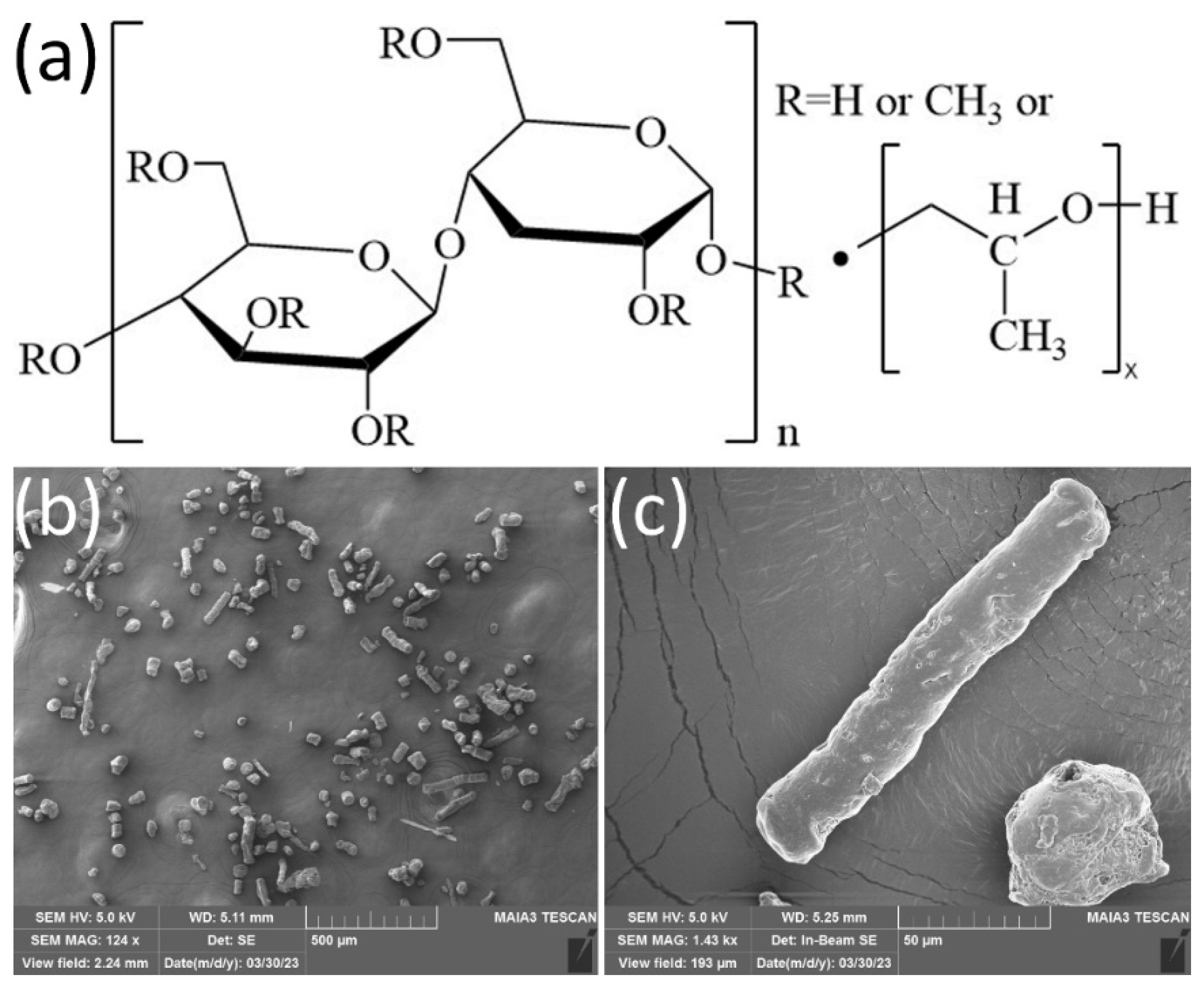
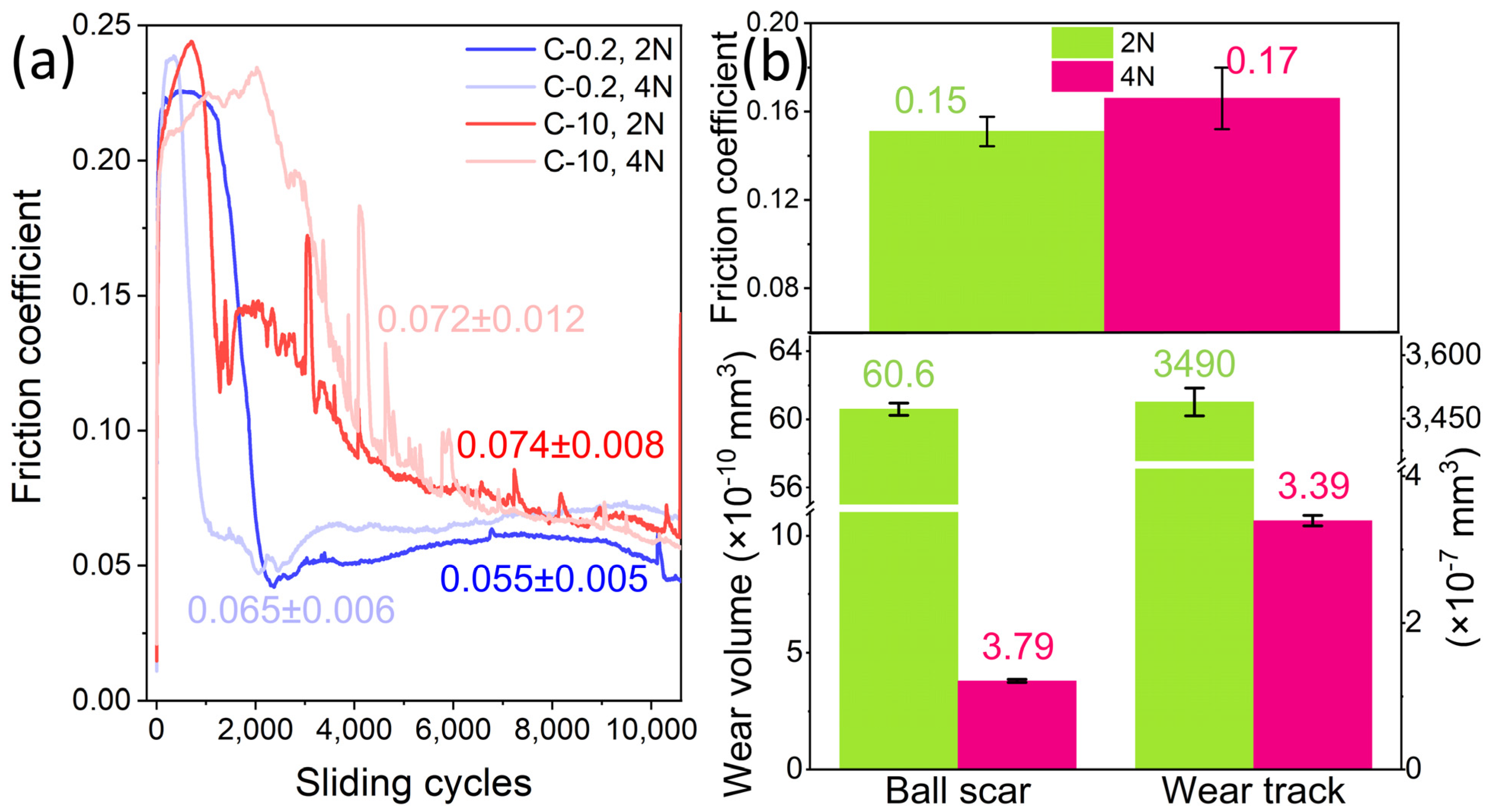
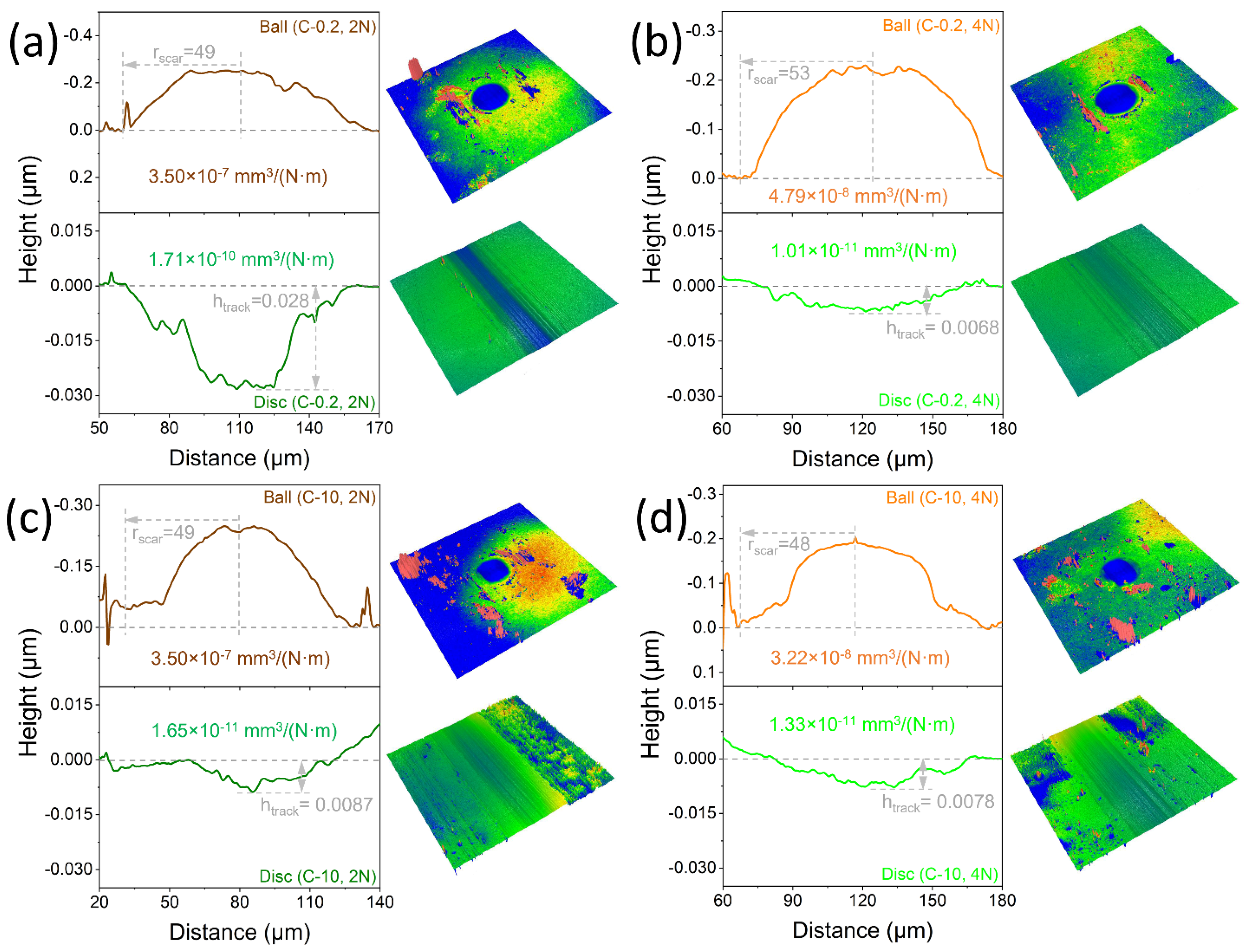
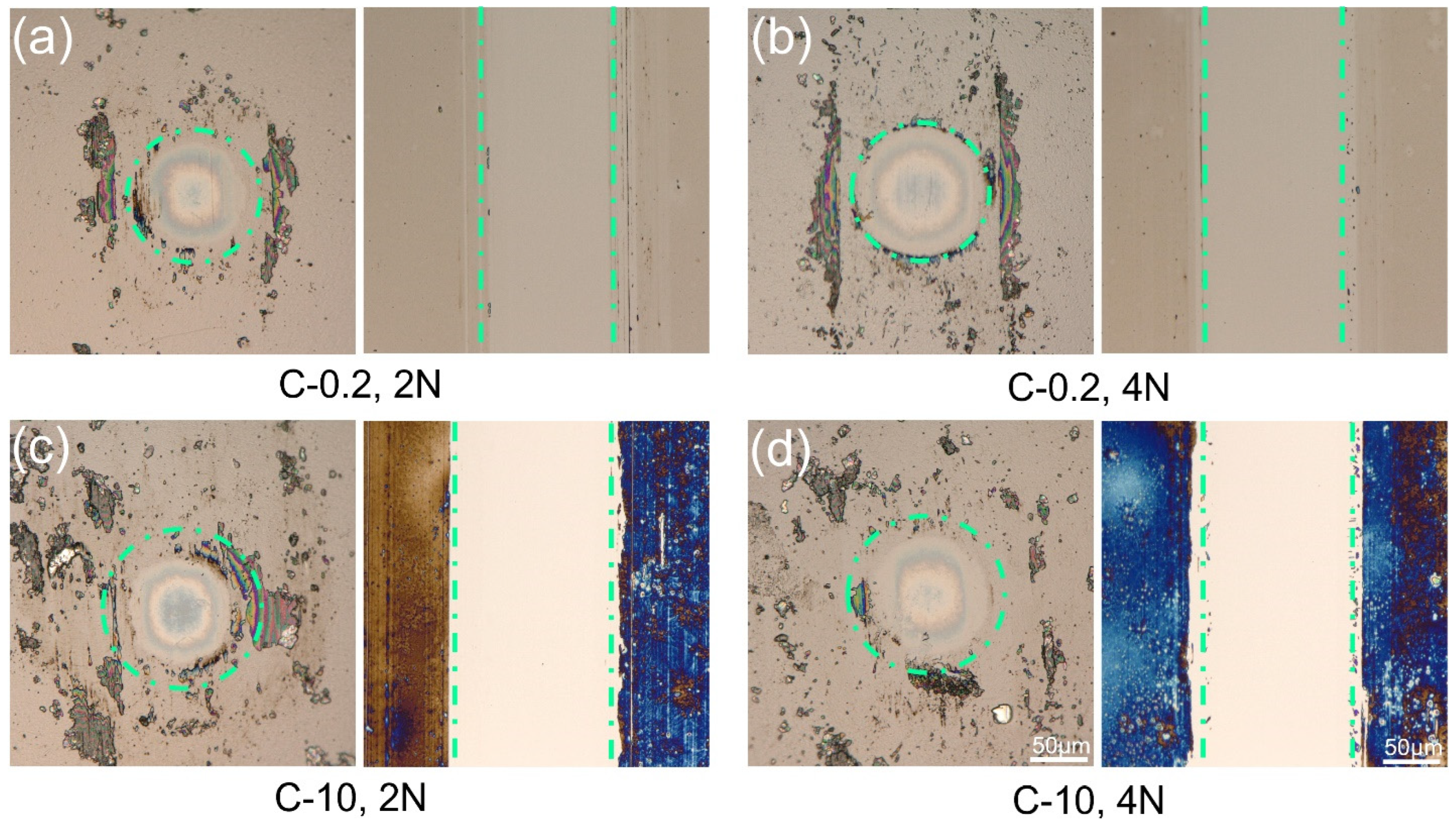

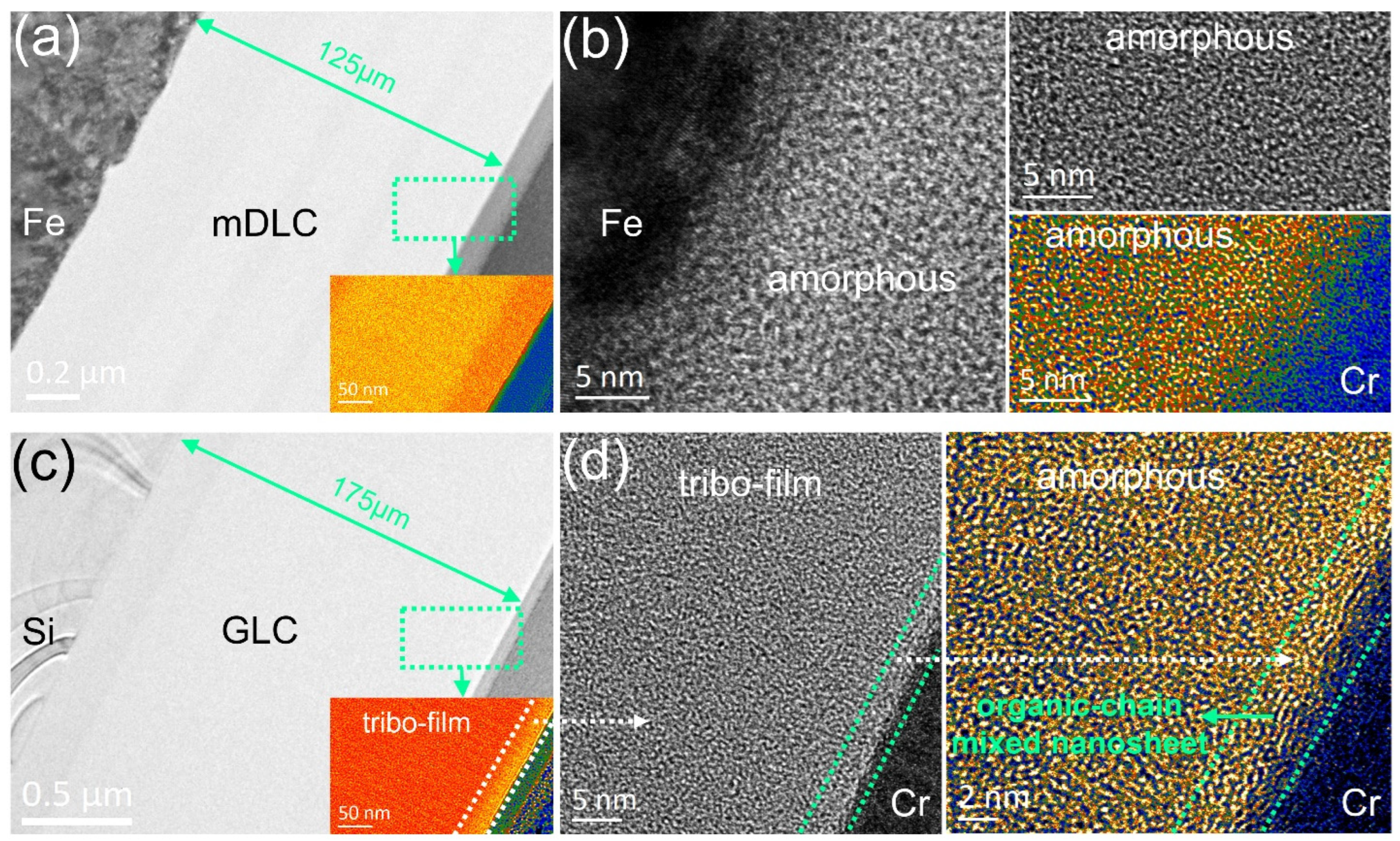
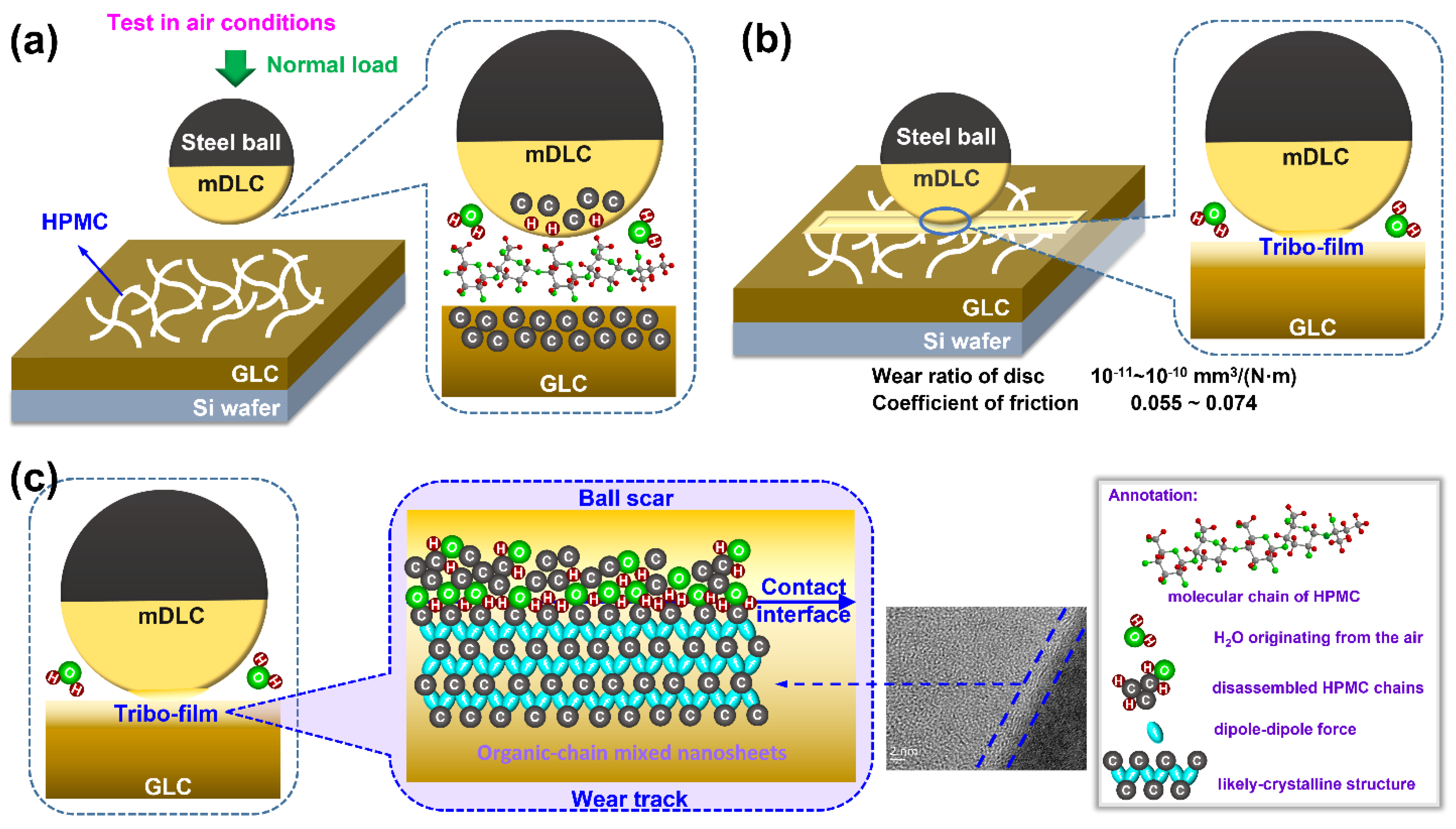
Disclaimer/Publisher’s Note: The statements, opinions and data contained in all publications are solely those of the individual author(s) and contributor(s) and not of MDPI and/or the editor(s). MDPI and/or the editor(s) disclaim responsibility for any injury to people or property resulting from any ideas, methods, instructions or products referred to in the content. |
© 2024 by the authors. Licensee MDPI, Basel, Switzerland. This article is an open access article distributed under the terms and conditions of the Creative Commons Attribution (CC BY) license (https://creativecommons.org/licenses/by/4.0/).
Share and Cite
Pang, H.; Xu, J.; Liu, H.; Wang, W.; Yin, X.; Liu, D.; Zhang, B. The Induced Orientation of Hydroxypropyl Methylcellulose Coating for Ultralow Wear. Lubricants 2024, 12, 129. https://doi.org/10.3390/lubricants12040129
Pang H, Xu J, Liu H, Wang W, Yin X, Liu D, Zhang B. The Induced Orientation of Hydroxypropyl Methylcellulose Coating for Ultralow Wear. Lubricants. 2024; 12(4):129. https://doi.org/10.3390/lubricants12040129
Chicago/Turabian StylePang, Haosheng, Jianxun Xu, Huan Liu, Wenjuan Wang, Xuan Yin, Dameng Liu, and Bing Zhang. 2024. "The Induced Orientation of Hydroxypropyl Methylcellulose Coating for Ultralow Wear" Lubricants 12, no. 4: 129. https://doi.org/10.3390/lubricants12040129




